
The Bottom Line
Introduction, Specifications, Pricing & Availability
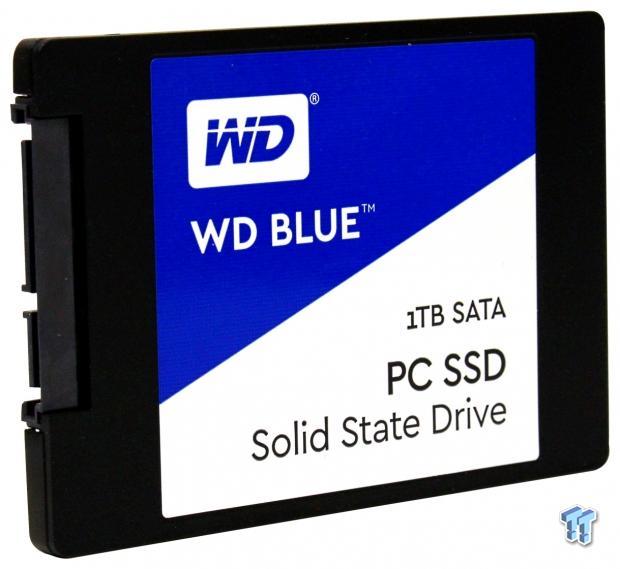
Seeing the handwriting flashing on the wall, Western Digital acquired SanDisk back in May of this year. As one of the world's largest mechanical HDD manufacturers, Western Digital has been a first-hand witness to the changing landscape of storage. It is becoming overwhelmingly obvious that the future has little room for mechanical storage media. If you are going to stay in the game, you had better get onboard the flash train. Not part way with SSHDs, but all the way or be left in the dustbin of history. To truly be a major player in the flash arena, you need fab-level access to NAND flash memory. More than anything else, this is the reason WD acquired SanDisk.
Western Digital's "Blue" SSD is effectively a SanDisk X400 with new firmware and some space on the drive's flash array dedicated to internal flash maintenance. This non-user addressable space dedicated for flash maintenance is known as overprovisioned space or "OP." Overprovisioning plays a key role in maintaining a high level of sustained performance as well as extending the overall endurance of a drive's flash array. The more OP, the better a drive will perform, and the longer it will last. SanDisk's X400 is already an excellent performer. In fact, it is one of our favorite planar TLC flash-based SSDs. Adding OP into the mix is only going to make an already fantastic product even better.
Western Digital is marketing their new "Blue" line of SSDs as an affordable HDD replacement that delivers superior performance, leading-edge reliability, and broad compatibility. These attributes are basically the same proposition that any modern SSD brings to the table, so other than Western Digital's worldwide recognized brand name, nothing special per se. Like the X400, the Blue is offered in both 2.5"x7mm cased and M.2 2280 form factors at all capacity points.
Because Western Digital's Blue series SSDs are based on SanDisk's X400 series, we already know that the WD Blue is going to deliver excellent performance. What we really want to know is how much better it will perform with new firmware and overprovisioning.
Specifications
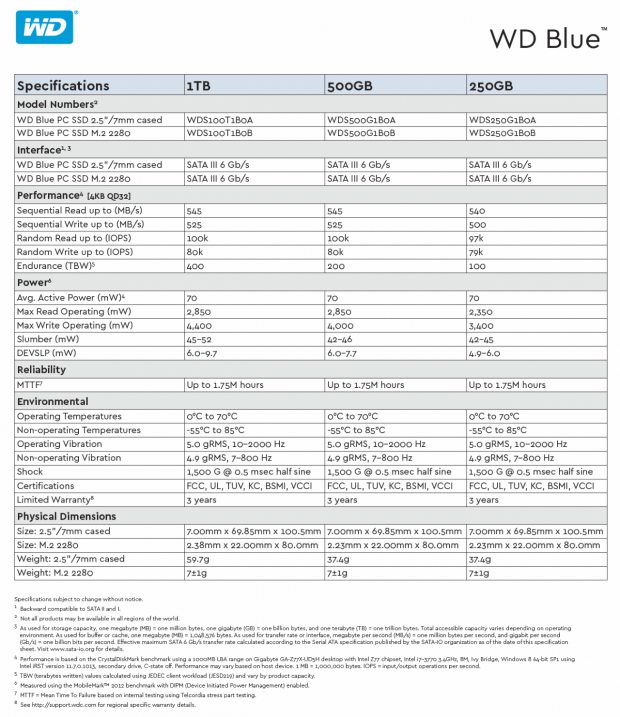
WD Blue 1TB SATA III SSD:
- Sequential Read: up to 540 MB/s
- Sequential Write: up to 525 MB/s
- Max 4K Random Read Speed: up to 100,000 IOPS
- Max 4K Random Write Speed: up to 80,000 IOPS
- Endurance: 400TBW
- MTTF: 1.7 Million Hours
- Warranty: 3-Year Limited Warranty
- Avg. Active Power Consumption: 70mW
- ECC: LDPC
- SMART
- TRIM
- Garbage Collection
- Software: WD SSD Dashboard
WD's Blue 1TB SATA III SSD is currently selling for $271 at Amazon and Newegg.
Powering the Blue is Marvell's 88SS1074 4-channel flash controller. We've seen this versatile controller at the heart of numerous recently-released SSDs. Marvel's 88SS1074 controller is essentially a blank slate. Marvell sells the controller and vendors provide their own custom firmware. Marvell's controller-only sales model means we don't see Marvell-controlled SSDs coming from small companies, but rather large companies that have in-house firmware engineering teams.
The Blue series pairs Marvell's 88SS1074 controller with SanDisk 15nm planar flash in BGA flash packages. BGA packaged flash is the good stuff; it is capable of higher bus speeds than TSOP packaged flash. Table caching is handled by Micron LPDDR3 DRAM cache packages with a capacity of 1MB to 1GB DRAM to NAND ratio.
WD backs the Blue with a three-year limited warranty. The limitation being TBW (Total Bytes Written). SanDisk's X400 carries a five-year limited warranty, but a lower TBW. We aren't sure of the reasoning behind the lower warranty period you get from the Blue, however, in our opinion, three years with an industry leading TBW is plenty good enough.
Drive Details
WD Blue 1TB SATA III SSD
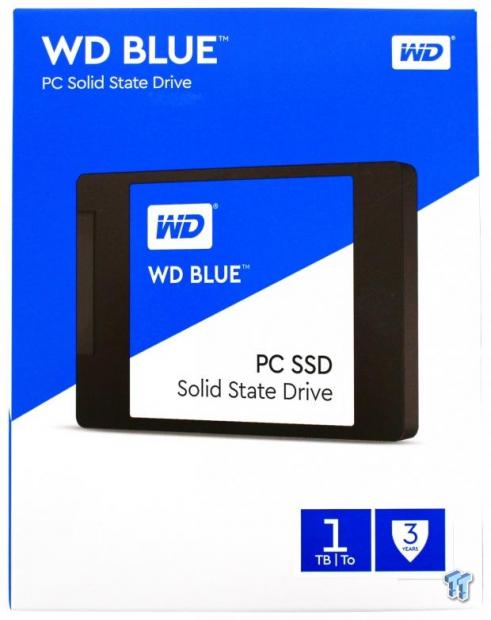
The blue and white themed packaging features a picture of the enclosed SSD on the front. The drive's capacity and three-year warranty are advertised on this side.
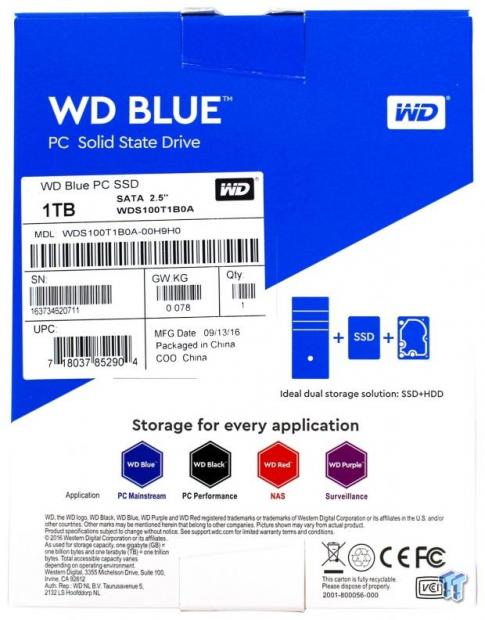
The rear of the packaging lists the particulars of the enclosed SSD. WD also suggests using their SSD along with an HDD is an ideal storage solution.

The top of the of the enclosure is plastic.
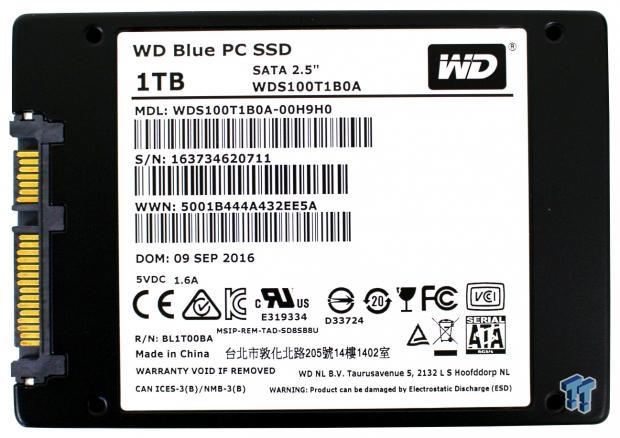
The bottom and sides of the enclosure are formed from sheet aluminum.
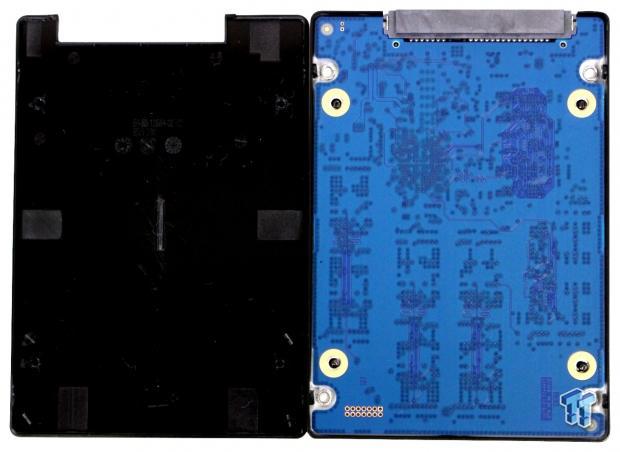
The enclosure is fastened together with four screws.
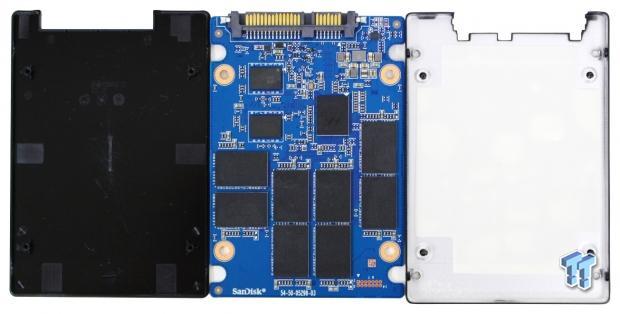
A thermal sheet wicks heat from the major components into the aluminum half of the enclosure.
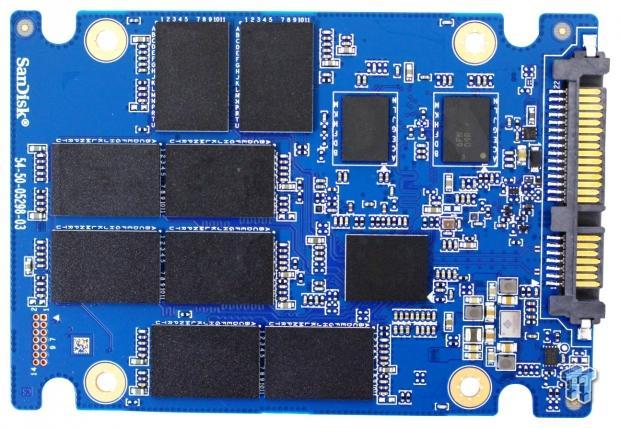
This half of the drive's PCB is populated with the drive's controller, eight 128GB SanDisk 15nm planar flash packages, and two Micron 512MB LPDDR3 DRAM cache packages.
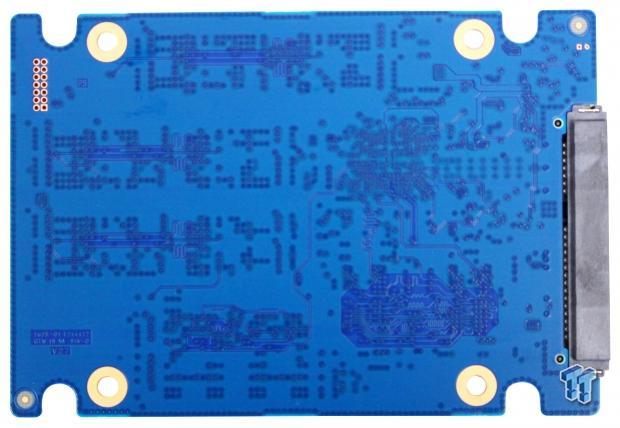
This half of the PCB is devoid of components.
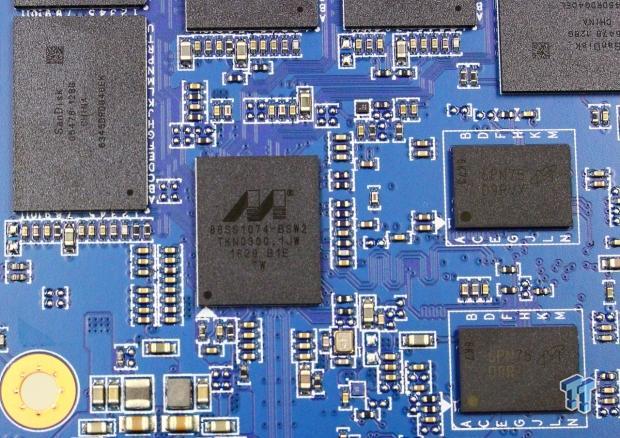
The Marvell 88SS1074 4-channel controller that powers the Blue.
Test System Setup and Properties
Jon's Consumer SSD Review Test System Specifications
- Motherboard: ASRock Extreme9 Z97 - Buy from Amazon
- CPU: Intel Core i7 4790K @ 4.8GHz - Buy from Amazon / Read our review
- Cooler: Swiftech H2O-320 Edge - Buy from Amazon / Read our review
- Memory: Corsair Dominator DDR3 32GB 2400MHz - Buy from Amazon
- Video Card: Onboard Video
- Case: IN WIN X-Frame - Buy from Amazon / Read our review
- Power Supply: Seasonic Platinum 1000 Watt Modular - Buy from Amazon / Read our review
- OS: Microsoft Windows 10 Professional 64-bit - Buy from Amazon
- Drivers: Intel RAID option ROM version 13.0.0.2075 and Intel RST driver version 14.8.0.1042
We would like to thank ASRock, Crucial, Intel, Corsair, RamCity, IN WIN, and Seasonic for making our test system possible.
Drive Properties
WD Blue 1TB OS Disk 75% Full
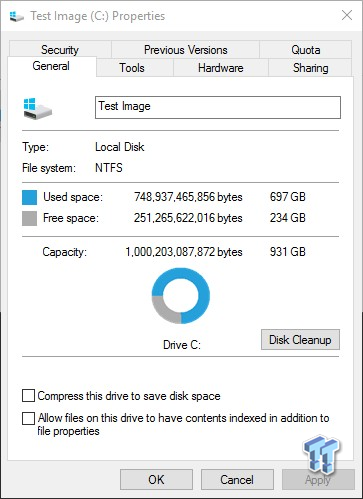
The majority of our testing is performed with our test drive as our boot volume. Our boot volume is 75% full for all OS Disk "C" drive testing to replicate a typical consumer OS volume implementation. We feel that most of you will be utilizing your SSDs for your boot volume and that presenting you with results from an OS volume is more relevant than presenting you with empty secondary volume results.
System settings: Cstates and Speed stepping are both disabled in our systems BIOS. Windows High-Performance power plan is enabled. Windows write caching is enabled, and Windows buffer flushing is disabled. We are utilizing Windows 10 Pro 64-bit OS for all of our testing except for our MOP (Maxed-Out Performance) benchmarks where we switch to Windows Server 2008 R2 64-bit. Empty Windows 10 benchmark screenshots will also be shown on our MOP page.
Synthetic Benchmarks – ATTO & Anvil's
ATTO
Version and / or Patch Used: 2.47
ATTO is a timeless benchmark used to provide manufacturers with data used for marketing storage products. With ATTO, we are looking at maximum sequential performance with compressible data as well as the performance curve.
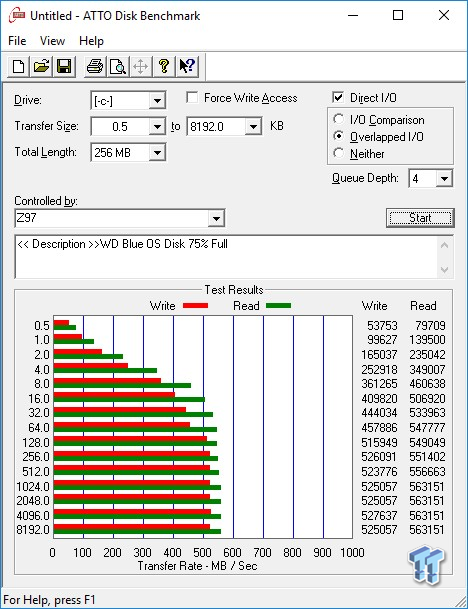
Compressible sequential read/write transfers max out at 563/527 MB/s. Both figures exceed WD's factory specs. Keep in mind this is our OS volume, and it is filled to 75% of its total capacity. Maximum sequential performance is achieved at 1MB transfers.
Sequential Write
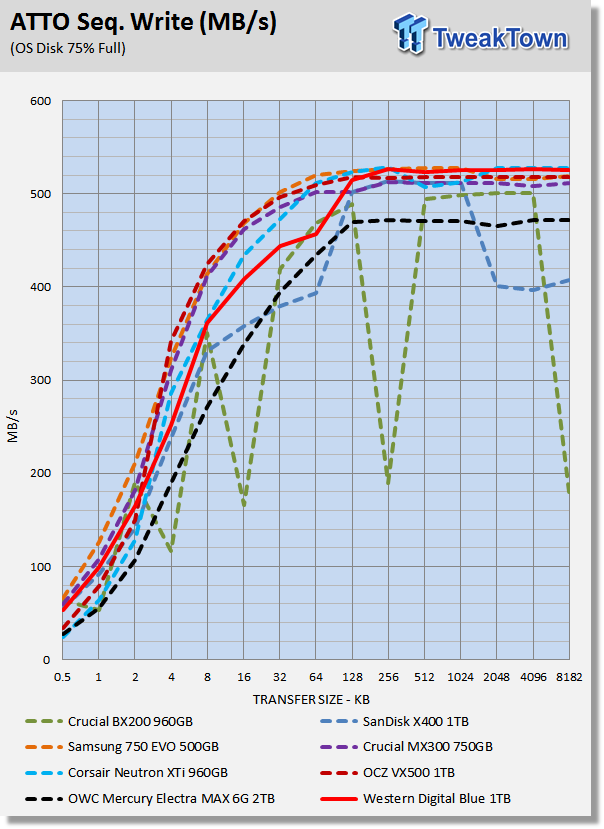
Right off the bat, we notice the WD Blue delivering a better performance curve than SanDisk's X400. We feel this is due to overprovisioning present on the Blue. The 750 EVO and MX300 both ramp up faster than the Blue.
Sequential Read
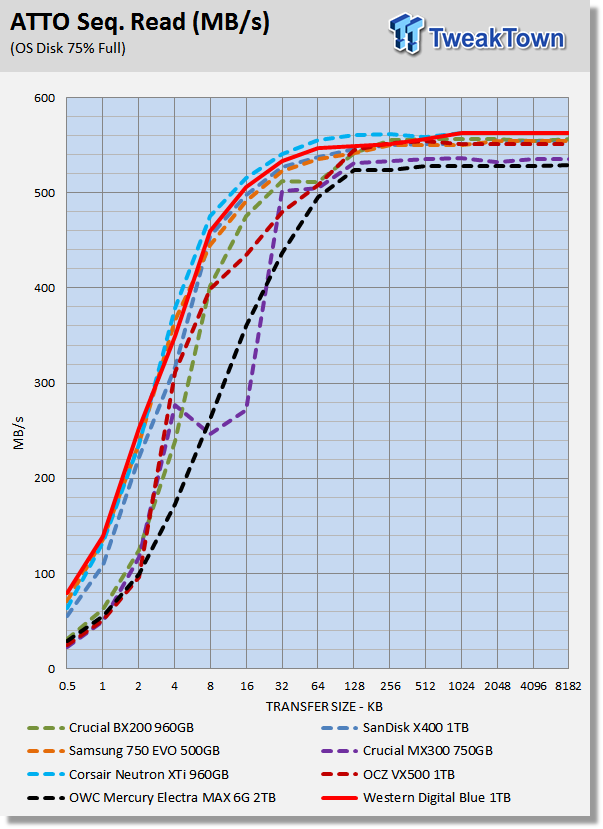
The Blue is delivering the best small file performance of the bunch. The MLC-powered XTi takes the lead in the middle of the test. The Blue leads the field at the end of the test. Again, we see the Blue outperforming the X400.
Anvil Storage Utilities
Version and / or Patch Used: 1.1.0
Anvil's Storage Utilities is a storage benchmark designed to measure the storage performance of SSDs. The Standard Storage Benchmark performs a series of tests; you can run a full test or just the read or write test, or you can run a single test, i.e. 4k QD16. With Anvil's, we are focused on the total score.
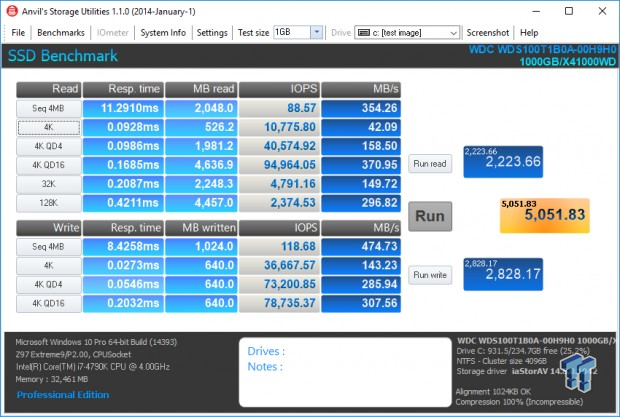
Scoring
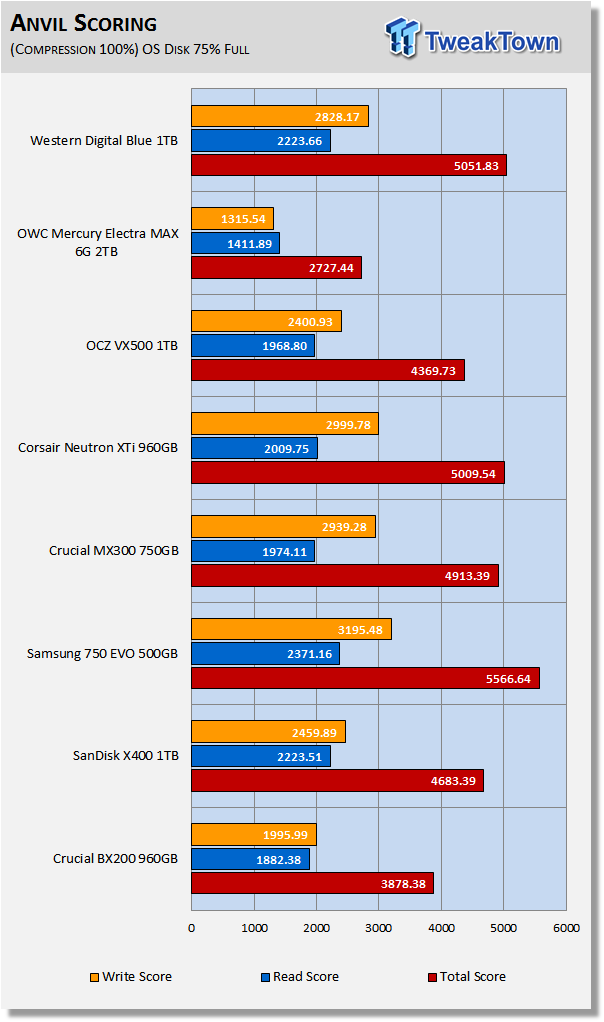
Anvil's scoring typically provides us with a good indication of a drive's overall synthetic performance. Whenever we get a score of over 5,000, we take notice. The Blue delivers a very impressive score of 5,051. This is second only to Samsung's 750 EVO. The Blue even manages to outscore the MLC-powered XTi.
Comparing the Blue to the X400, we find the Blue delivering far better write performance and a far better total score. We consider 4K QD1 random read performance to be one of the best indicators of how well a drive will perform as an OS disk. We consider 10K at QD1 a milestone that very few SSDs are capable of delivering. Only the best can do it, and the Blue does it with ease.
(Anvil) Read IOPS through Queue Depth Scale
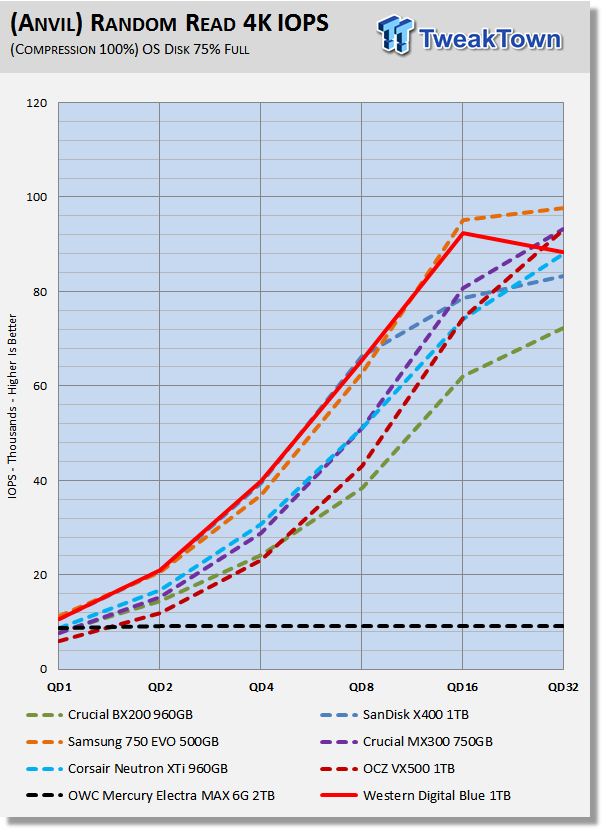
The Blue and X400 both deliver superior performance up to QD8, after which the Blue outperforms the X400. The Blue and X400 both deliver the goods at low queue depths which is what we are looking for when judging synthetic performance.
(Anvil) Write IOPS through Queue Scale
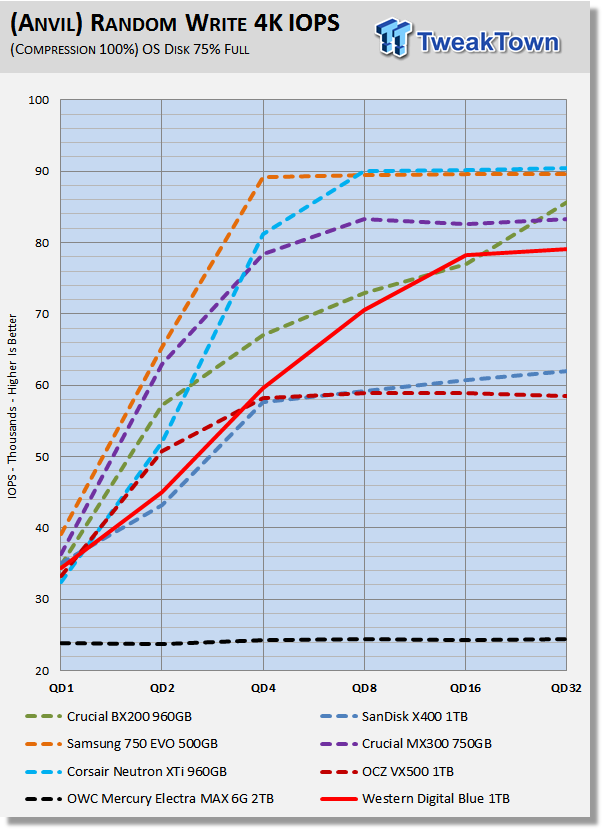
The Blue does outperform the X400 across the board. However, both are outperformed by the majority of the competing drives in our test pool.
Synthetic Benchmarks – CDM & AS SSD
CrystalDiskMark
Version and / or Patch Used: 3.0 Technical Preview
CrystalDiskMark is disk benchmark software that allows us to benchmark 4k and 4k queue depths with accuracy. Note: Crystal Disk Mark 3.0 Technical Preview was used for these tests since it offers the ability to measure native command queuing at QD4. With this version of CDM, we are focused on 4K random performance at QD1 and QD4.
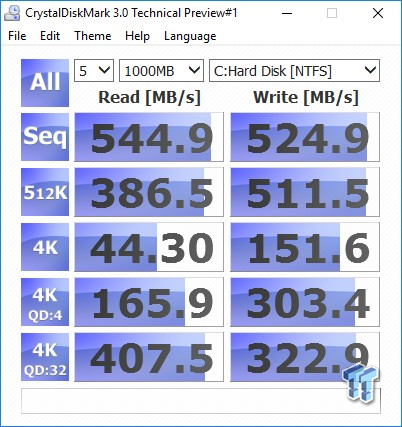
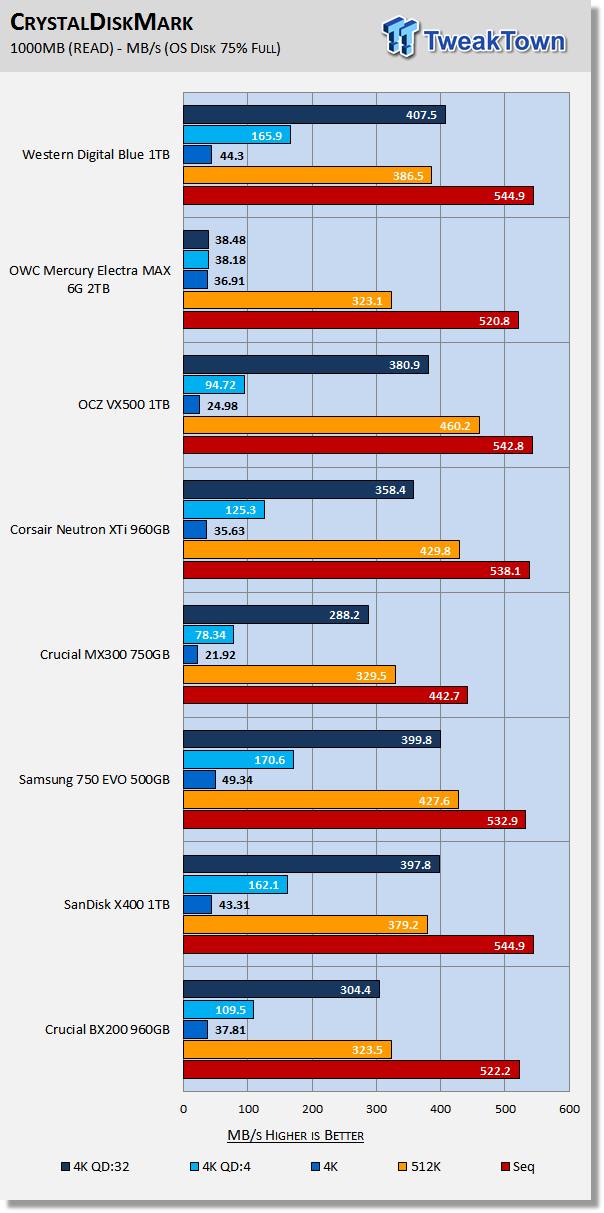
Focusing in on 4K QD1 and 4K QD4, we are getting very strong performance from the Blue, X400, and 750 EVO. All three are delivering elite performance. The EVO wins but not by a whole lot. The Blue manages to best the X400 again. We will point out the Blue's performance at QD32 because at 407 MB/s it is the highest we've seen from any SATA SSD with this particular test.
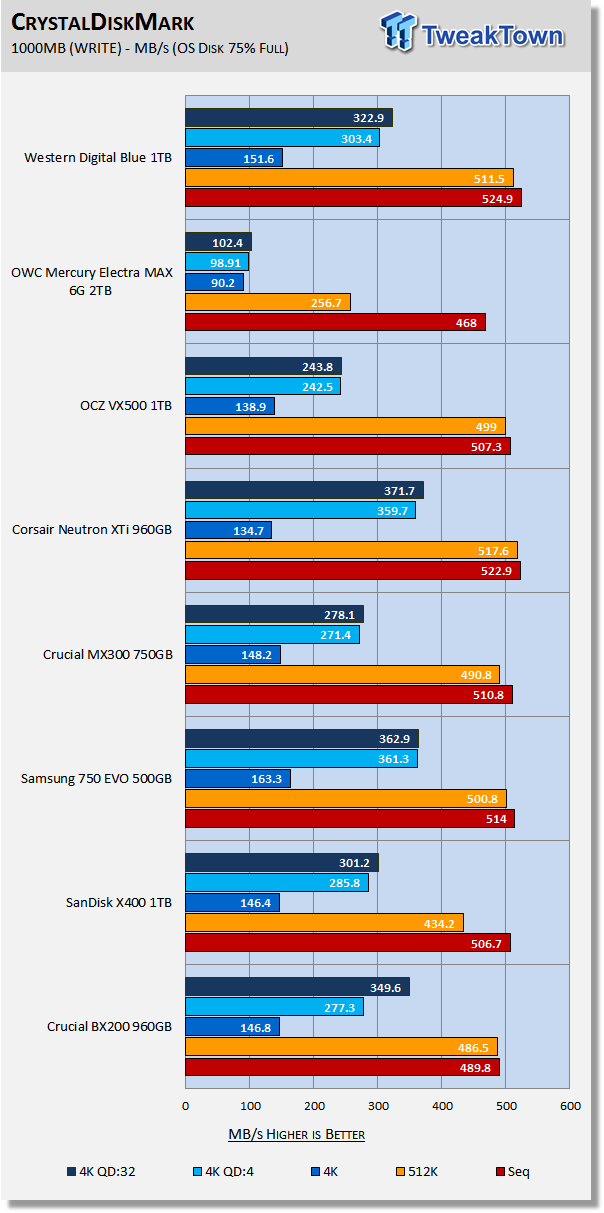
At QD1, the Blue is second only to the 750 EVO. At QD4, the Blue is bested by the XTi and 750 EVO. The Blue delivers exceptional low QD write performance. Sequentially, the Blue outperforms the rest of the test pool.
AS SSD
Version and / or Patch Used: 1.8.5611.39791
AS SSD determines the performance of SSDs. The tool contains four synthetic as well as three practice tests. The synthetic tests are to determine the sequential and random read and write performance of the SSD. We focus on total score when evaluating AS SSD.
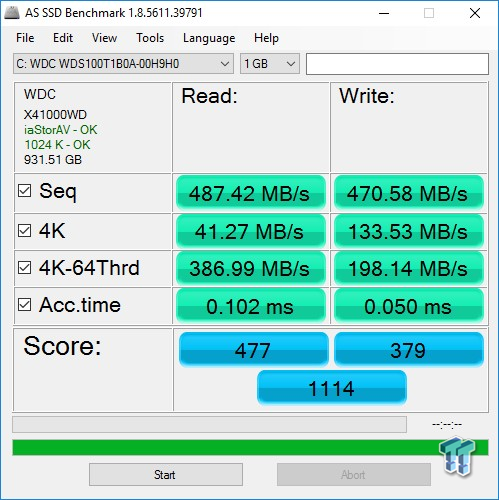
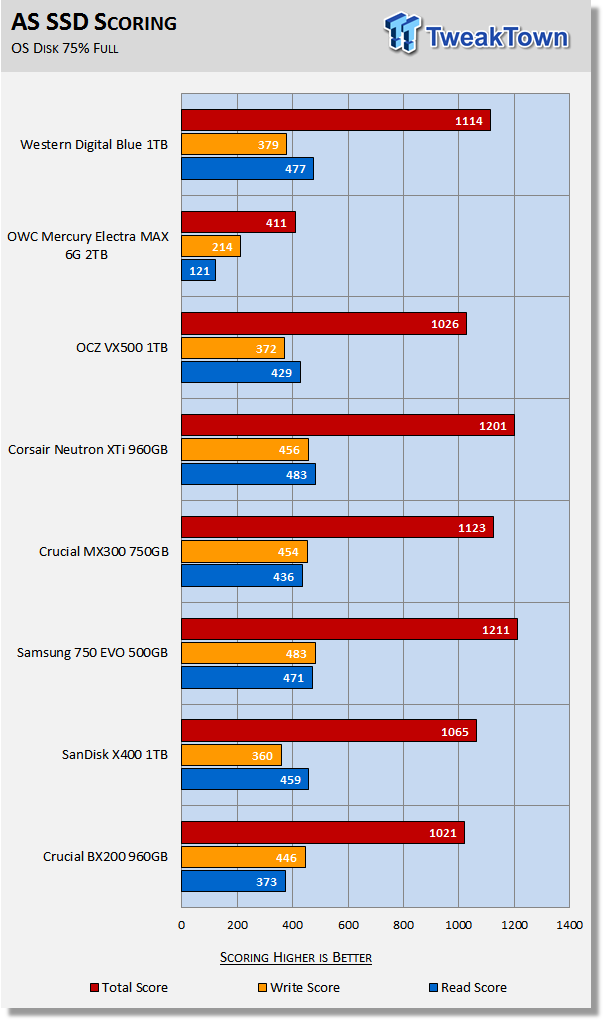
AS SSD is a demanding test. With AS SSD we are looking for a minimum score of 1000 from a planar TLC SSD. The Blue gives us what we are looking for. The Blue again outperforms the X400 due to OP and superior firmware.
Benchmarks (Trace, OS Volume) - Vantage, PCMark 7 & PCMark 8
Moderate Workload Model
We categorize these tests as indicative of a moderate workload environment.
PCMark Vantage - Hard Disk Tests
Version and / or Patch Used: 1.2.0.0
The reason we like PCMark Vantage is because the recorded traces are played back without system stops. What we see is the raw performance of the drive. This allows us to see a marked difference between scoring that other trace-based benchmarks do not exhibit. An example of a marked difference in scoring on the same drive would be empty vs. filled vs. steady state.
We run Vantage three ways. The first run is with the OS drive 75% full to simulate a lightly used OS volume filled with data to an amount we feel is common for most users. The second run is with the OS volume written into a "Steady State" utilizing SNIA's guidelines. Steady state testing simulates a drive's performance similar to that of a drive that been subjected to consumer workloads for extensive amounts of time. The third run is a Vantage HDD test with the test drive attached as an empty, lightly used secondary device.
OS Volume 75% Full - Lightly Used
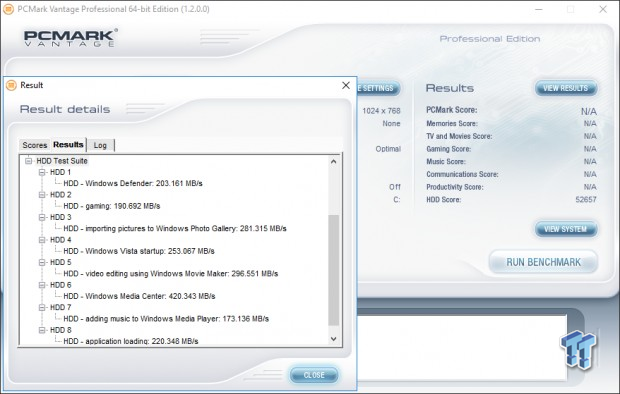
OS Volume 75% Full - Steady State
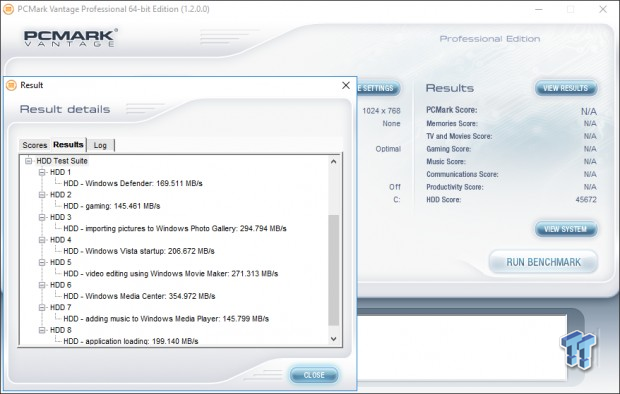
Secondary Volume Empty - FOB
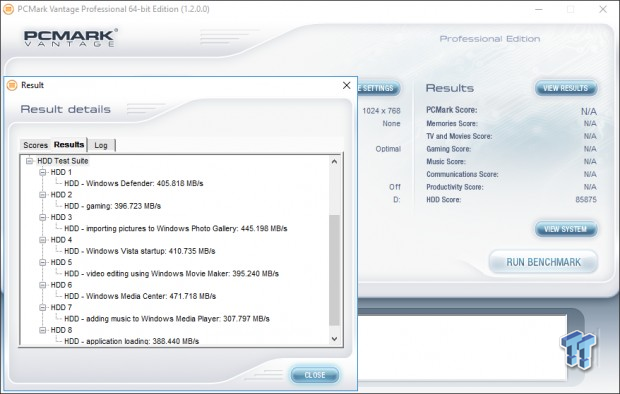
There's a big difference between an empty drive, one that's 75% full/used, and one that's in a steady state.
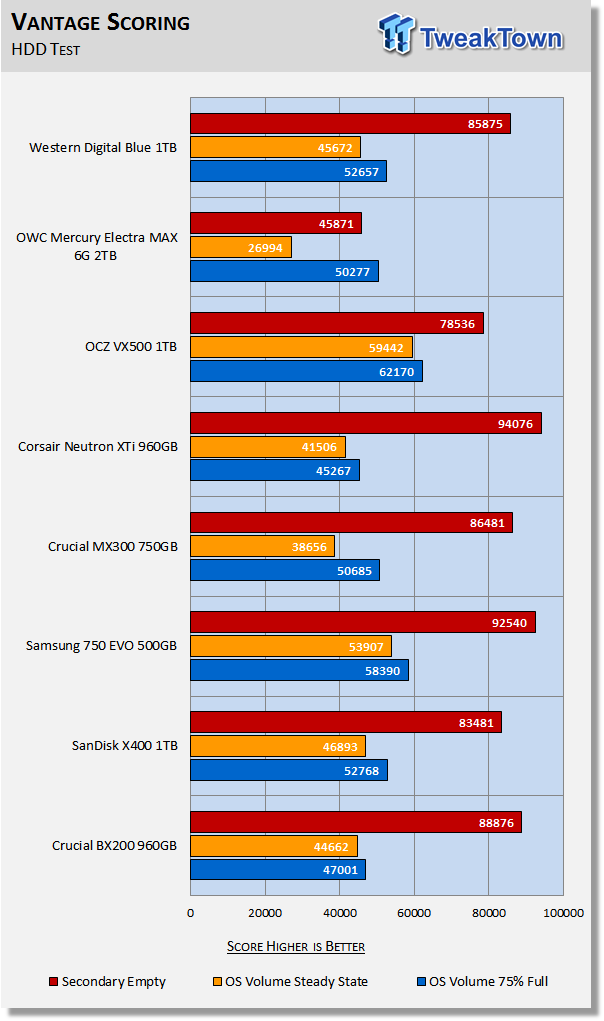
The important scores to pay attention to are "OS Volume Steady State" and "OS Volume 75% full." These two categories are most important because they are indicative of typical of consumer user states. When a drive is in a steady state, it means garbage collection is running at the same time it's reading/writing. This is exactly why we focus on steady state performance.
This is what we like about the X400 and the Blue. They are both moderate workload powerhouses. Both perform equally well when data is on the drive.
PCMark 7 - System Storage
Version and / or Patch Used: 1.4.0
We will look to Raw System Storage scoring for evaluation because it's done without system stops and, therefore, allows us to see significant scoring differences between drives.
OS Volume 75% Full - Lightly Used
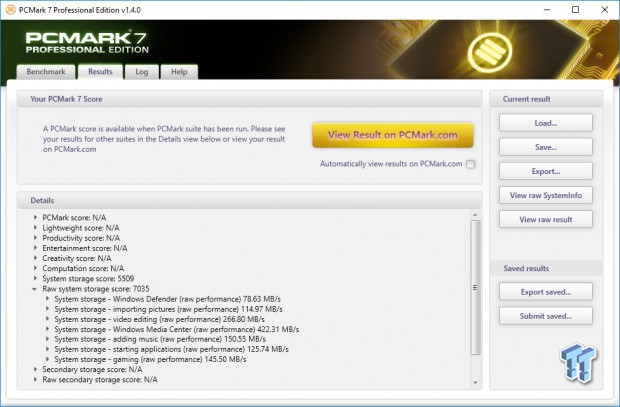
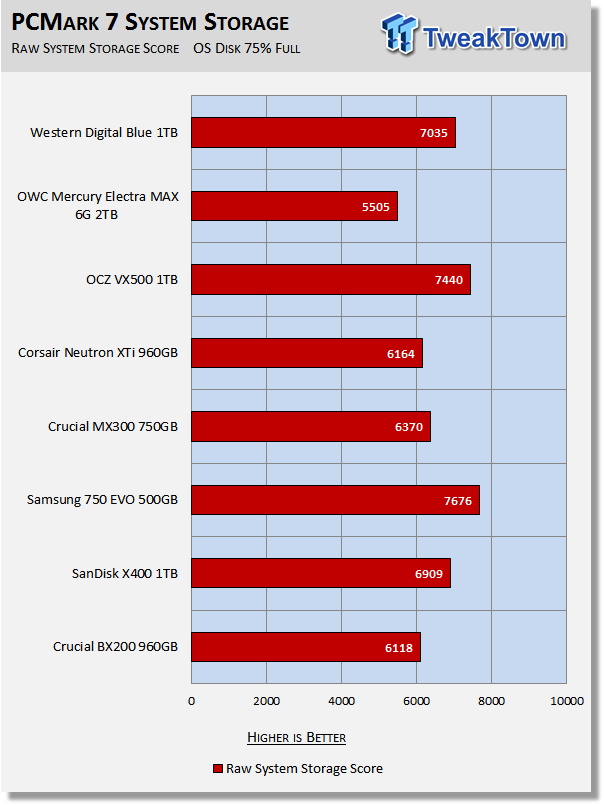
Whenever a SATA SSD scores 7K or above with PCMark 7, it is in an elite class.
PCMark 8 - Storage Bandwidth
Version and / or Patch Used: 2.4.304
We use PCMark 8 Storage benchmark to test the performance of SSDs, HDDs, and hybrid drives with traces recorded from Adobe Creative Suite, Microsoft Office, and a selection of popular games. You can test the system drive or any other recognized storage device, including local external drives. Unlike synthetic storage tests, the PCMark 8 Storage benchmark highlights real-world performance differences between storage devices. We focus on the total storage bandwidth when evaluating PCMark 8 results.
OS Volume 75% Full - Lightly Used
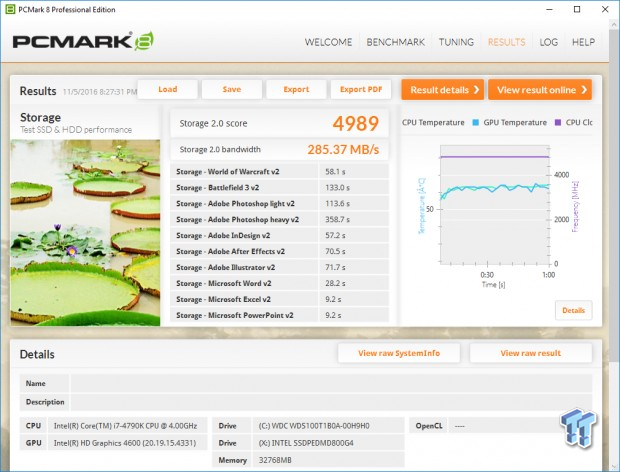
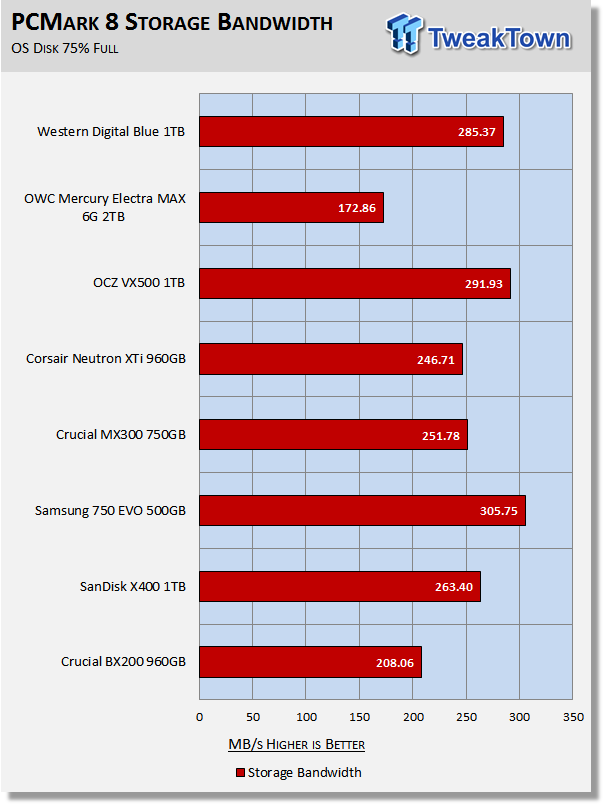
PCMark 8 is the most intensive moderate workload simulation we run. With respect to moderate workloads, this test is what we consider the best indicator of a drive's overall performance. As PCMark 8 shows, the WD Blue is a moderate workload powerhouse. There are only a handful of SATA SSDs that have better moderate workload performance than the WD Blue and all of them are more expensive. Additionally, when we compare the Blue to the X400, we can see the dividends that overprovisioning pays.
Benchmarks (Secondary) – IOPS, Response & Transfers
Iometer – Maximum IOPS
Version and / or Patch Used: Iometer 2014
We use Iometer to measure high queue depth performance. (No Partition)
Max IOPS Read
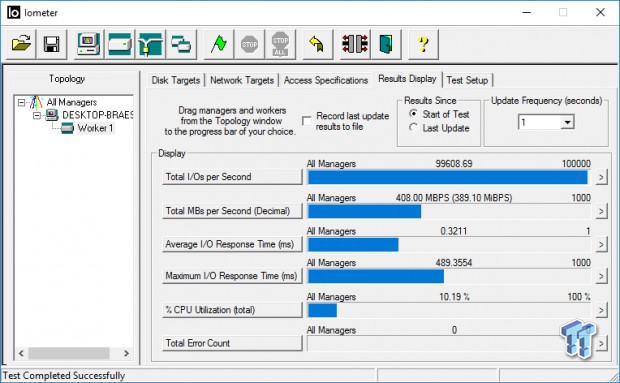
Max IOPS Write
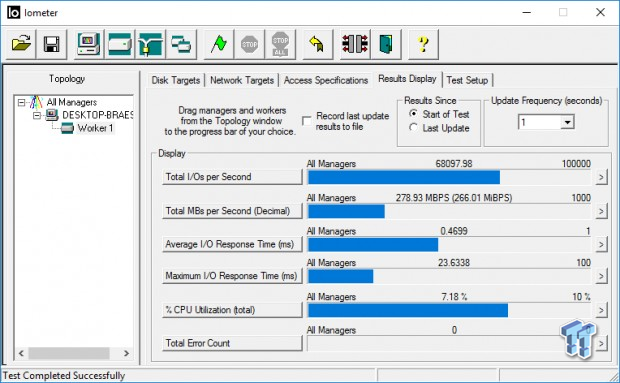
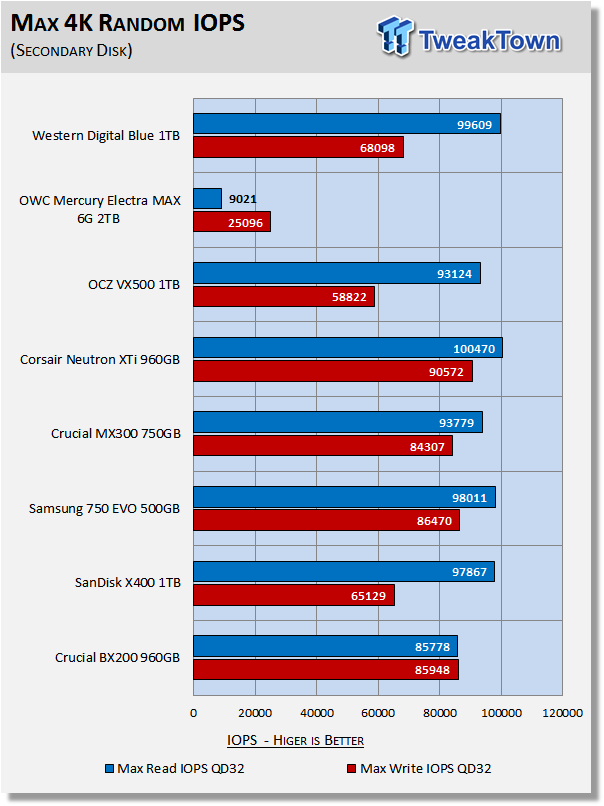
The WD Blue hit (close enough) its factory spec of 100K read IOPS. Write IOPS are 12K lower than factory spec. It does hit 80K plus for about 10 seconds but falls off after that. We test for 30 seconds, which is why the WD Blue failed to finish the test at factory spec.
Iometer – Disk Response
Version and / or Patch Used: Iometer 2014
We use Iometer to measure disk response times. Disk response times are measured at an industry accepted standard of 4K QD1 for both write and read. Each test runs twice for 30 seconds consecutively, with a 5-second ramp-up before each test. We partition the drive/array as a secondary device for this testing.
Avg. Write Response
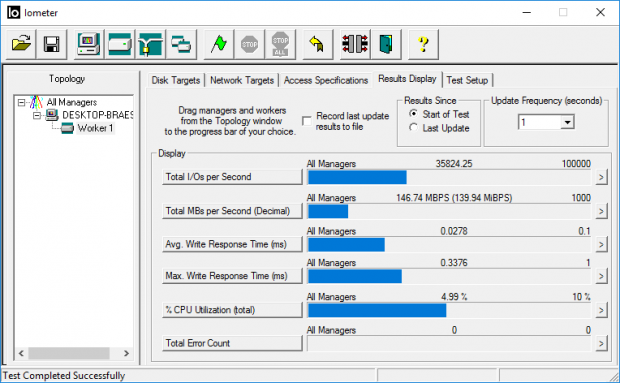
Avg. Read Response
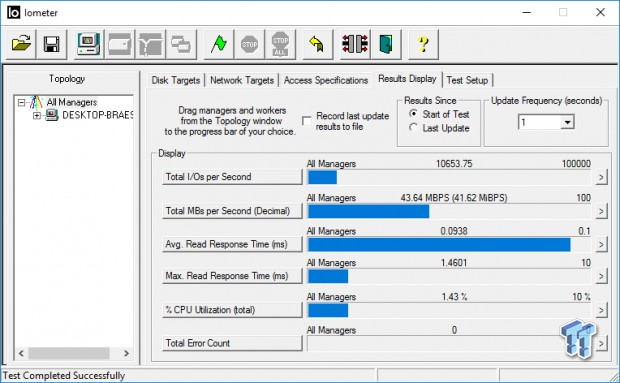
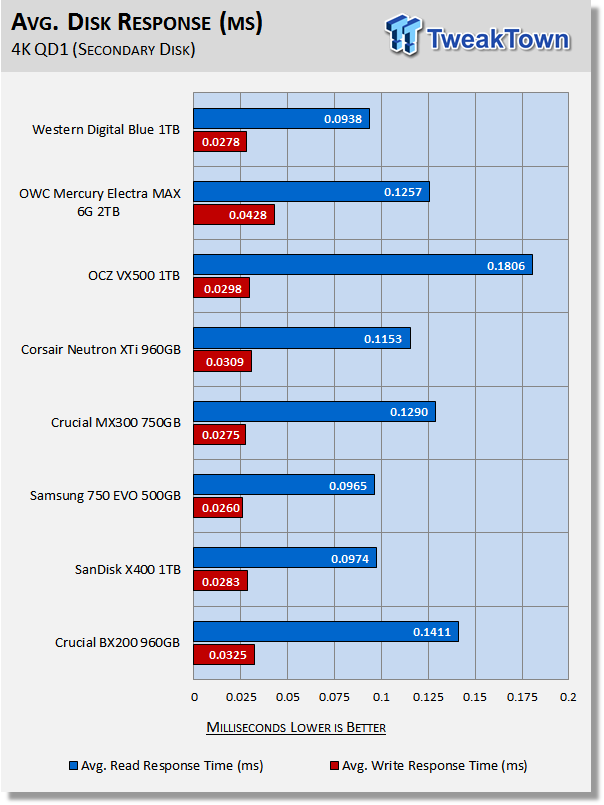
The WD Blue delivers significantly better read response than the rest of the drives in our test pool including the 750 EVO. Looking at the screenshot, we again see the WD Blue easily surpassing 10K at 4K QD1.
DiskBench - Directory Copy
Version and / or Patch Used: 2.6.2.0
We use DiskBench to time a 28.6GB block (9,882 files in 1,247 folders) composed primarily of incompressible sequential and random data as it's transferred from our DC P3700 PCIe NVME SSD to our test drive. We then read from a 6GB zip file that's part of our 28.6GB data block to determine the test drive's read transfer rate. Our system is restarted prior to the read test to clear any cached data, ensuring an accurate test result.
Write Transfer Rate
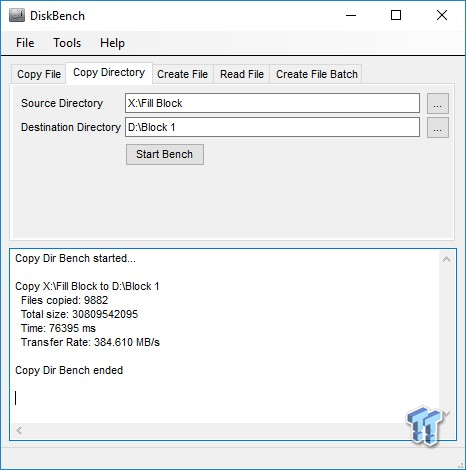
Read Transfer Rate
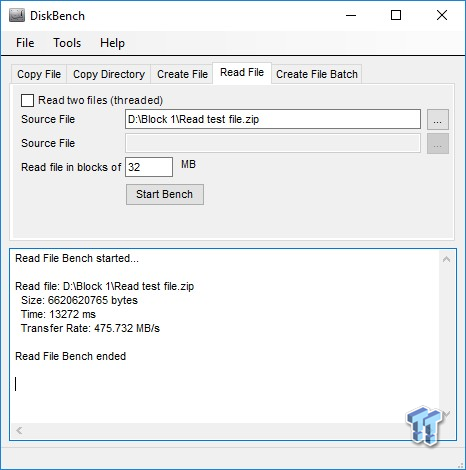
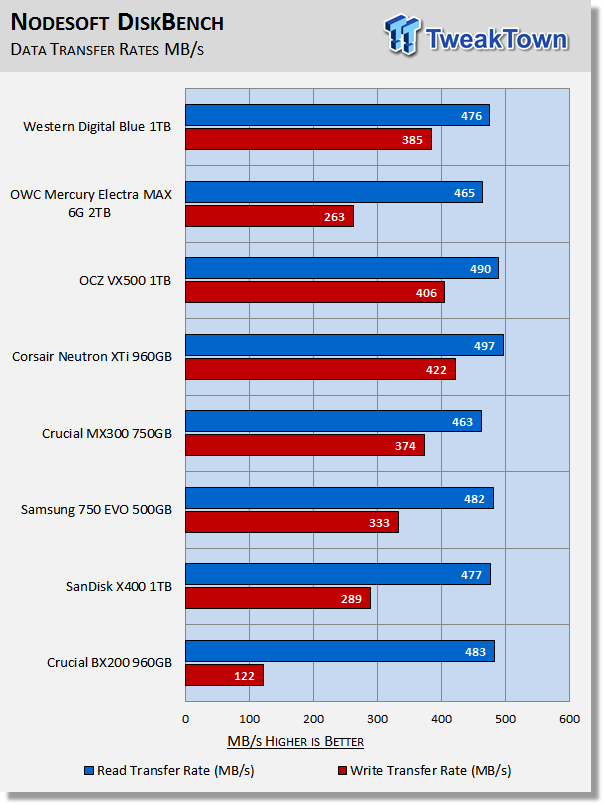
When testing write transfer rates, we have a rule of thumb. If any SSD cannot achieve 200 MB/s with our write transfer test, that SSD will not receive a TweakTown recommendation. WD's Blue passes with flying colors.
Benchmarks (Secondary) – PCMark 8 Extended
Futuremark PCMark 8 Extended
Heavy Workload Model
PCMark 8's consistency test simulates an extended duration heavy workload environment. PCMark 8 has built-in, command line executed storage testing. The PCMark 8 Consistency test measures the performance consistency and the degradation tendency of a storage system.
The Storage test workloads are repeated. Between each repetition, the storage system is bombarded with a usage that causes degraded drive performance. In the first part of the test, the cycle continues until a steady degraded level of performance has been reached. (Steady State)
In the second part, the recovery of the system is tested by allowing the system to idle and measuring the performance after 5-minute long intervals. (Internal drive maintenance: Garbage Collection (GC)) The test reports the performance level at the start, the degraded steady-state, and the recovered state, as well as the number of iterations required to reach the degraded state and the recovered state.
We feel Futuremark's Consistency Test is the best test ever devised to show the true performance of solid state storage in an extended duration heavy workload environment. This test takes on average 13 to 17 hours to complete and writes somewhere between 450GB and 14,000GB of test data depending on the drive. If you want to know what an SSDs steady state performance is going to look like during a heavy workload, this test will show you.
Here's a breakdown of Futuremark's Consistency Test:
Precondition phase:
1. Write to the drive sequentially through up to the reported capacity with random data.
2. Write the drive through a second time (to take care of overprovisioning).
Degradation phase:
1. Run writes of random size between 8*512 and 2048*512 bytes on random offsets for 10 minutes.
2. Run performance test (one pass only).
3. Repeat 1 and 2 for 8 times, and on each pass increase the duration of random writes by 5 minutes.
Steady state phase:
1. Run writes of random size between 8*512 and 2048*512 bytes on random offsets for 50 minutes.
2. Run performance test (one pass only).
3. Repeat 1 and 2 for 5 times.
Recovery phase:
1. Idle for 5 minutes.
2. Run performance test (one pass only).
3. Repeat 1 and 2 for 5 times.
Storage Bandwidth
PCMark 8's Consistency test provides a ton of data output that we use to judge a drive's performance.
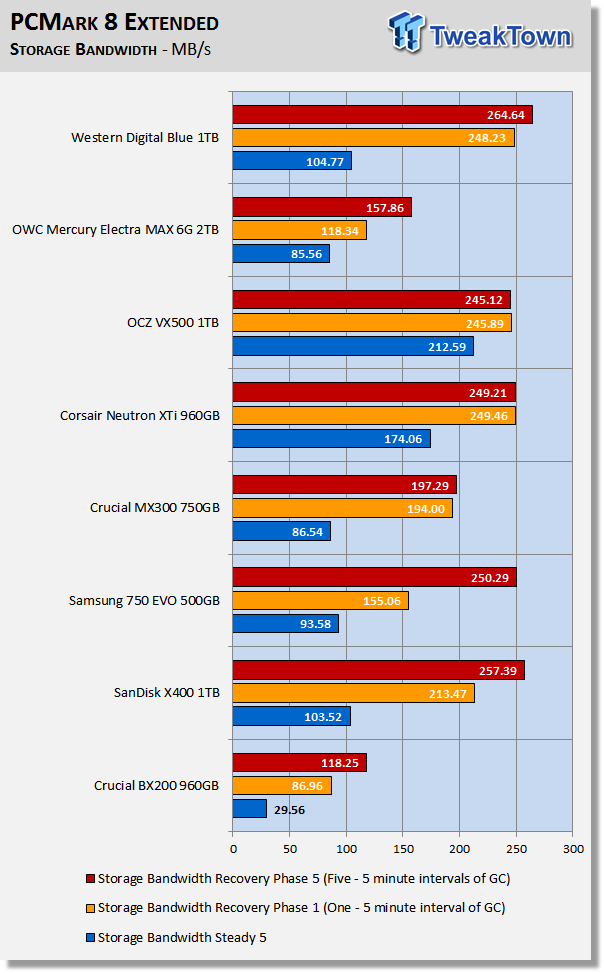
We consider steady state bandwidth (the blue bar) our test that carries the most weight in ranking a drive/arrays heavy workload performance. Performance after Garbage Collection (GC) (the orange and red bars) is what we consider the second most important consideration when ranking a drive's performance. Trace-based steady state testing is where true high performing SSDs are separated from the rest of the pack.
When evaluating TLC-based SSDs, we like to focus on recovery performance more than steady-state. Our reasoning is that consumers who purchase low-cost TLC SSDs aren't going to be running workloads intense enough to induce a steady-state. Based on recovery performance the WD Blue wins this test outright.
Bandwidth at Test Phase
We chart our test subject's storage bandwidth as reported at each of the test's 18 trace iterations. This gives us a good visual perspective of how our test subjects perform as testing progresses. This chart sheds more light on how the drives perform as they progress through the testing phases.
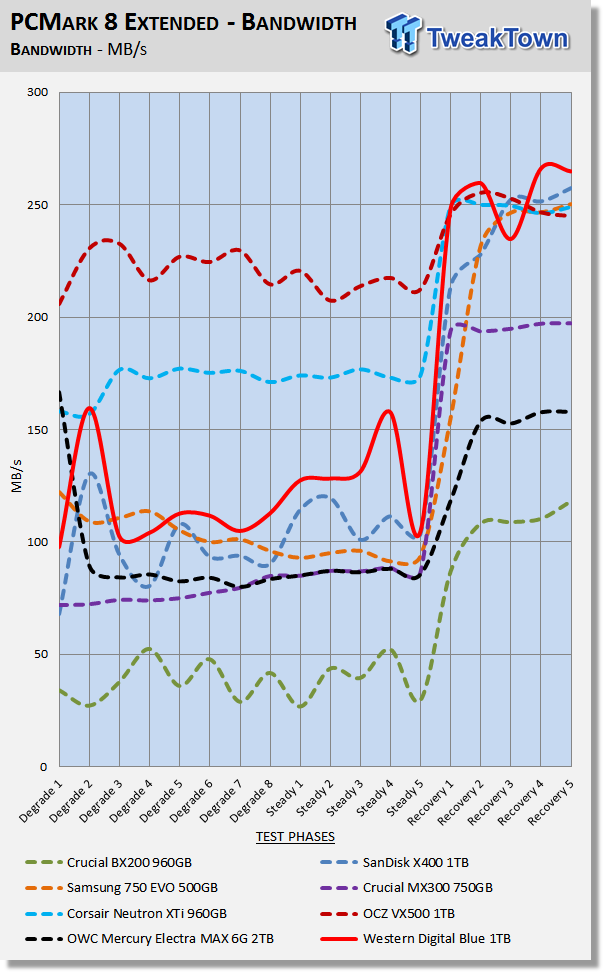
The WD Blue is the best performing TLC-based SSD in our test pool.
Total Access Time (Latency)
We chart the total time the disk is accessed as reported at each of the test's 18 trace iterations.
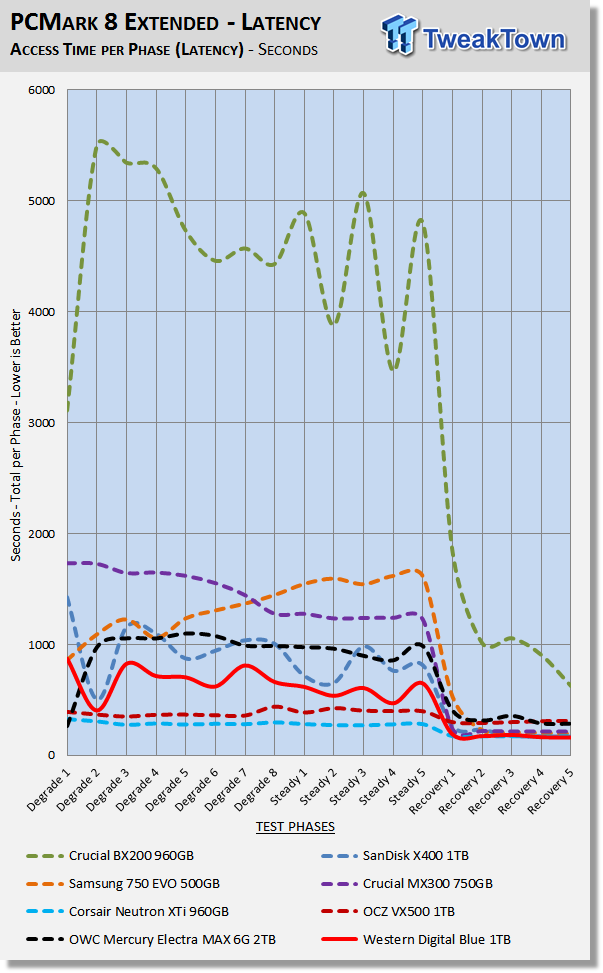
Low latency translates to the real-world as snappiness.
Disk Busy Time
Disk Busy Time is how long the disk is busy working. We chart the total time the disk is working as reported at each of the tests 18 trace iterations.
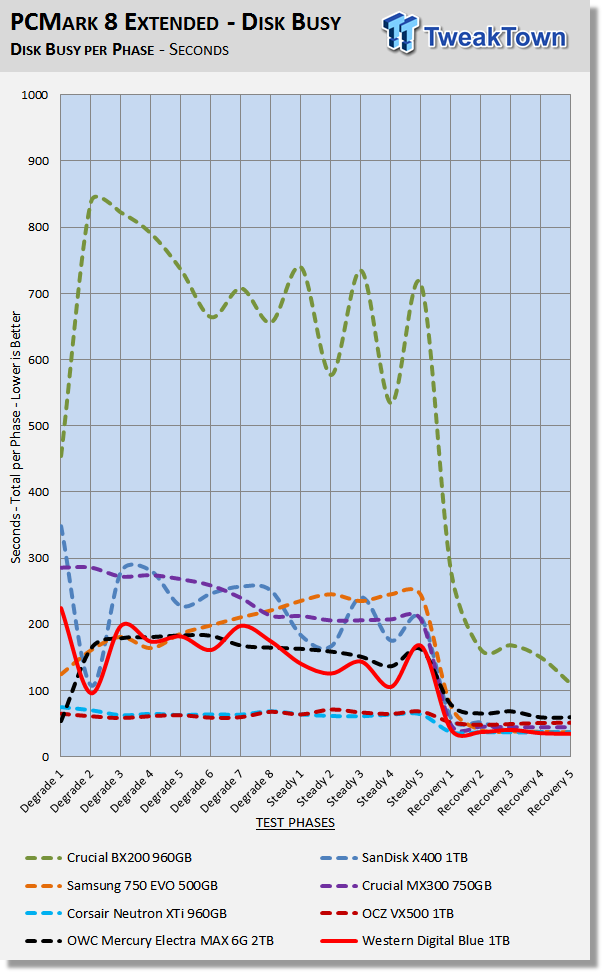
When latency is low, disk busy time is low as well.
Data Written
We measure the total amount of random data that our test drive/array is capable of writing during the degradation phases of the consistency test. Pre-conditioning data is not included in the total. The total combined time that degradation data is written to the drive/array is 470 minutes. This can be very telling. The better a drive/array can process a continuous stream of random data; the more data will be written.
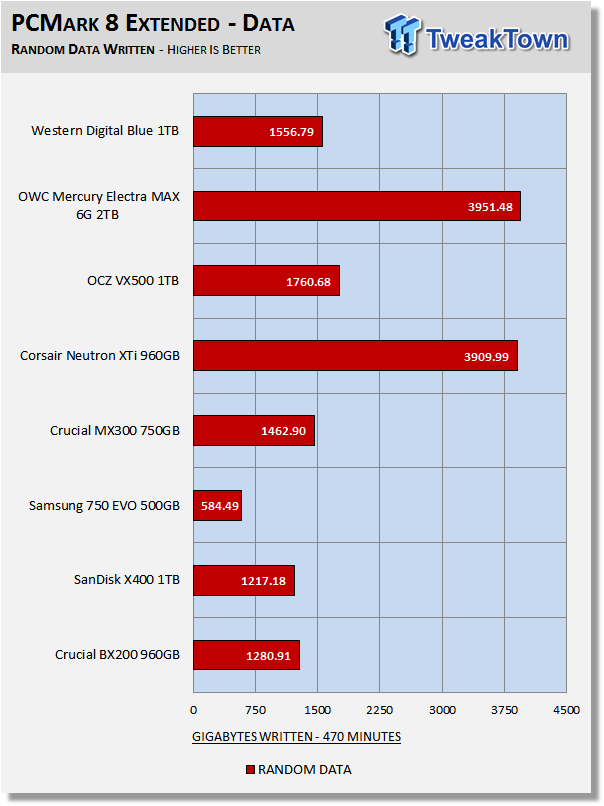
Overprovisioning and write latency are the biggest factors that determine the outcome of this portion of the test. The WD Blue has some OP, the SanDisk X400 does not, which is why the Blue is able to write more data.
Benchmarks (Secondary) – 70/30 Mixed Workload
70/30 Mixed Workload Test (Sledgehammer)
Version and / or Patch Used: Iometer 2014
Heavy Workload Model
This test hammers a drive so hard we've dubbed it "Sledgehammer." Our 70/30 Mixed Workload test is designed to simulate a heavy-duty enthusiast/workstation steady-state environment. We feel that a mix of 70% read/30% write, full random 4K transfers best represents this type of user environment. Our test allows us to see the drive enter into and reach a steady state as the test progresses.
Phase one of the test preconditions the drive for 1 hour with 128K sequential writes. Phase two of the test runs a 70% read/30% write, full random 4K transfer workload on the drive for 1 hour. We log and chart (phase two) IOPS data at 5-second intervals for 1 hour (720 data points). 60 data points = 5 minutes.
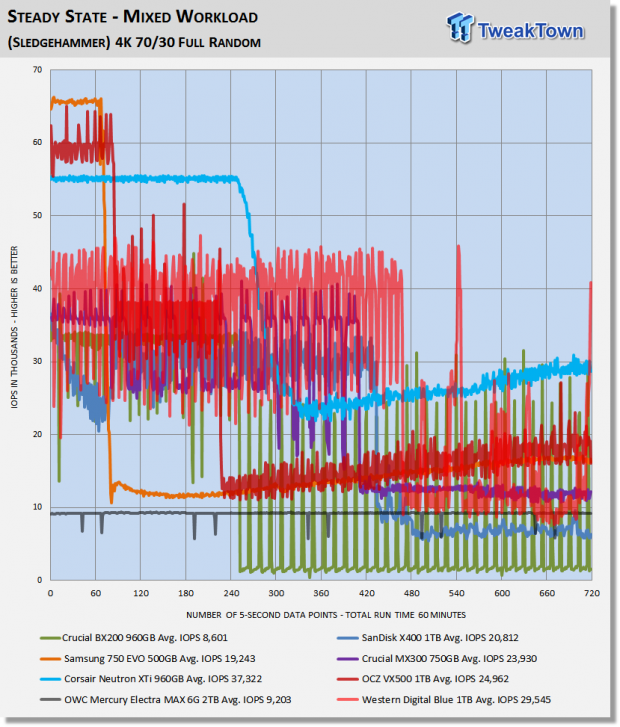
What we like about this test is that it reflects reality. Everything lines up, as it should. Consumer drives don't outperform Enterprise-Class SSDs that were designed for enterprise workloads. Consumer drives based on old technology are not outperforming modern Performance-Class SSDs, etc.
The Blue shows once again that it will outperform the 750 EVO with heavy-duty workloads. The Blue delivers 50% better heavy workload performance than the X400 because it is overprovisioned. We preconditioned the Blue for three hours instead of the usual one hour to assure the accuracy of this result.
Maxed-Out Performance (MOP)
This testing is just to see what the drive is capable of in an FOB (Fresh Out of Box) state under optimal conditions. We are utilizing empty volumes of Windows 10 and Windows Server 2008 R2 64-bit for this testing.
Windows 10 MOP
WD Blue 1TB
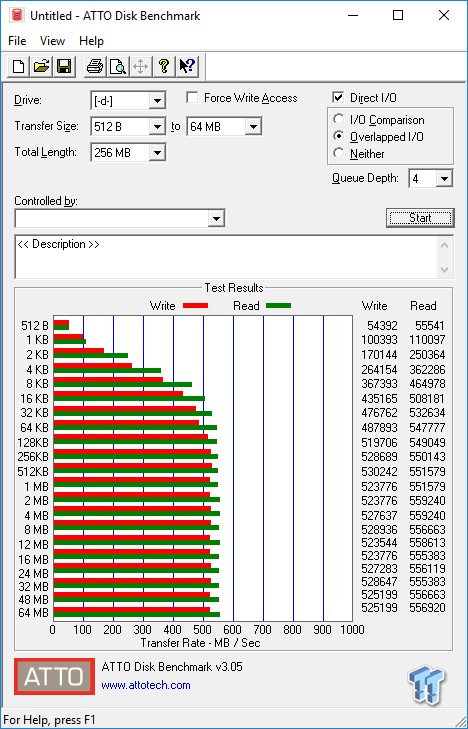
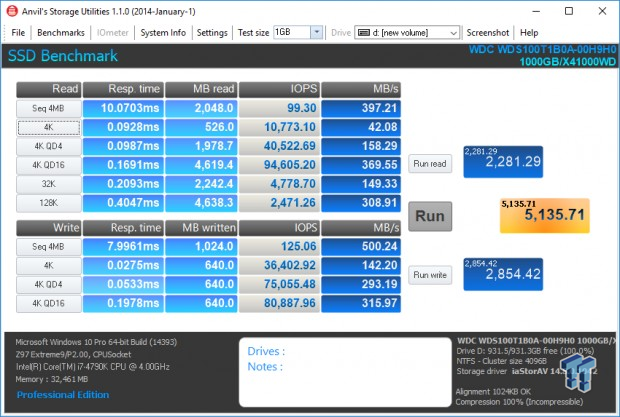
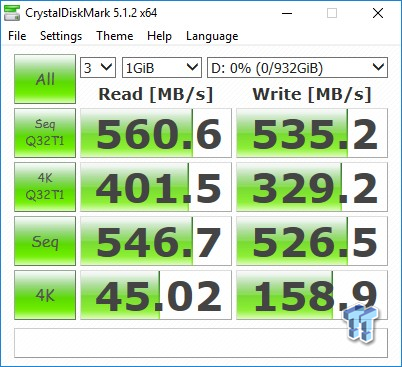
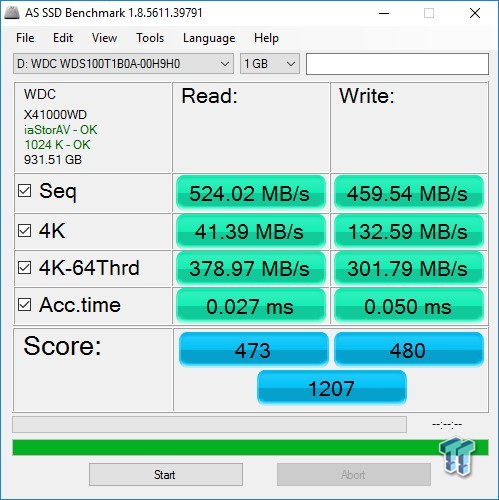
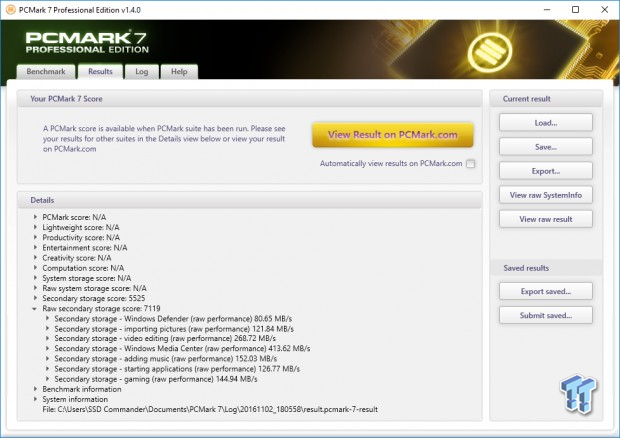
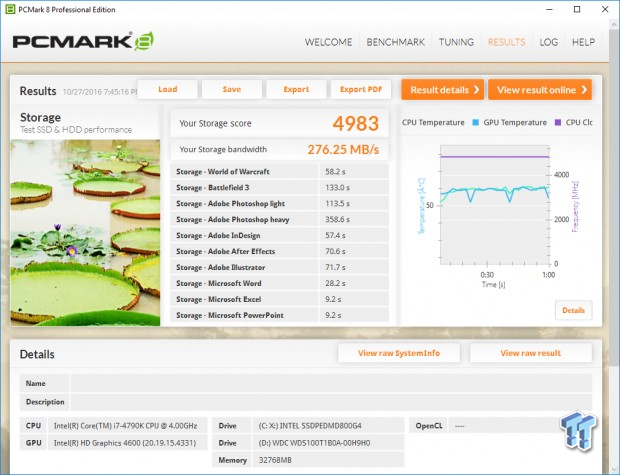
Windows Server 2008 R2 MOP
WD Blue 1TB
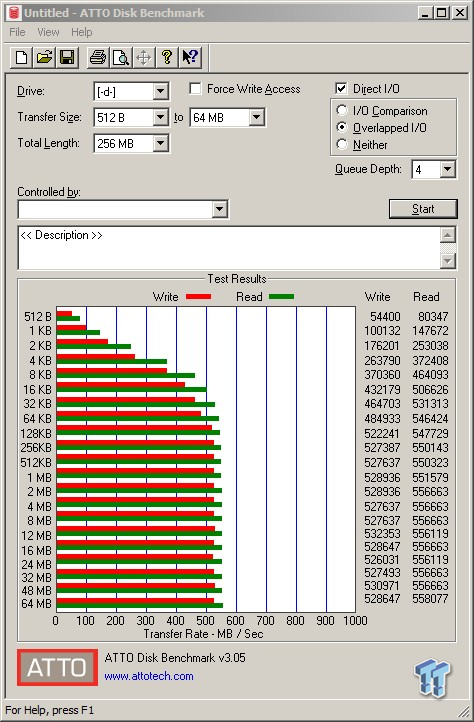
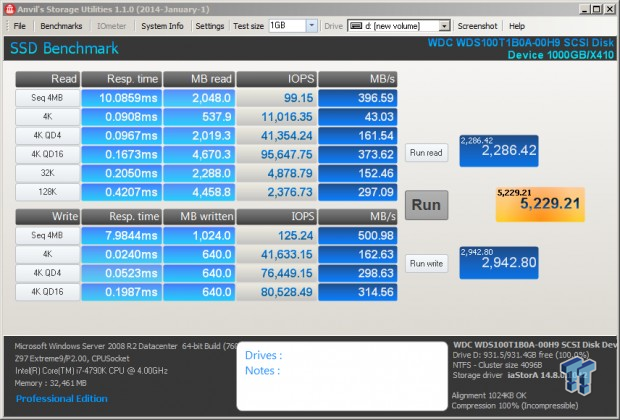
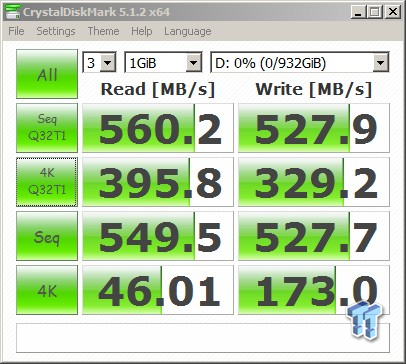
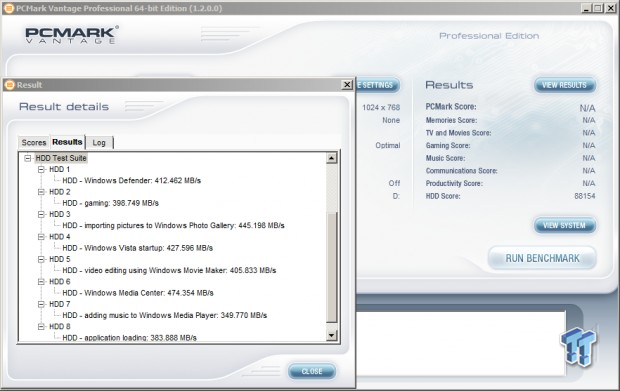
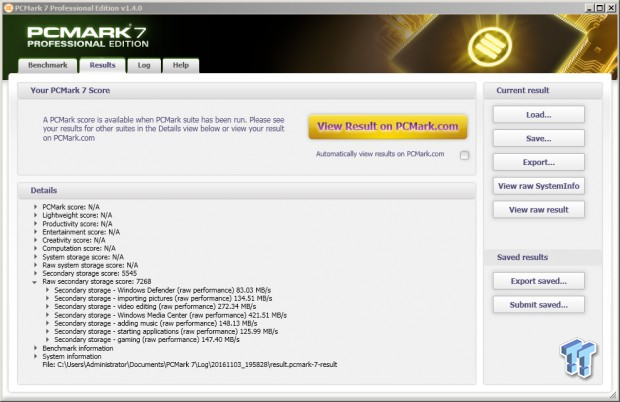
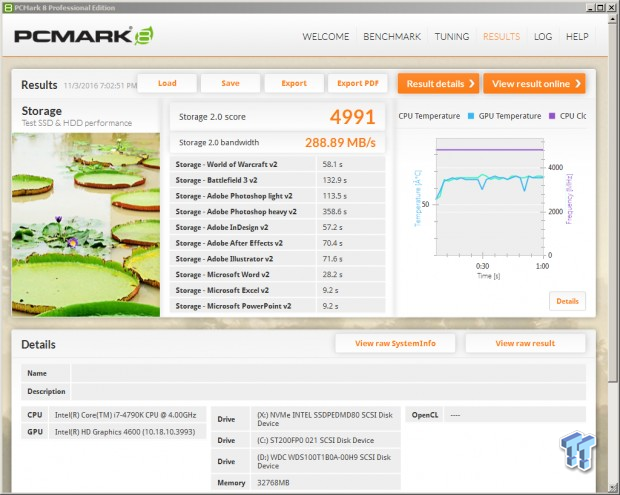
Final Thoughts
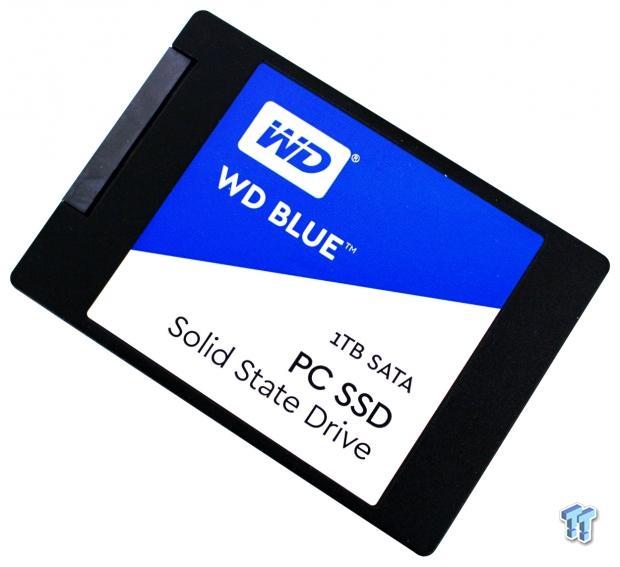
When we reviewed the SanDisk X400, it caught us by surprise because it was the first non-Samsung SATA-based TLC SSD that delivered moderate workload performance that is compelling. We feel that moderate workload performance is the best indicator of how well a SSD will perform in an OS environment for the majority of users. Whenever a SATA based SSD delivers random performance of over 10,000 IOPS at 4K QD1 read, it is indeed something special.
Western Digital's Blue SSD is, in fact, an X400, but it is even better because WD incorporated overprovisioning. Throughout our testing, the WD Blue displayed front and center that OP does have a significant impact on overall performance. The Blue outperformed the X400 significantly with the lone exception of our Vantage testing.
We tend to view things from an enthusiast perspective, and when viewed through this lens, the Blue is definitely a better choice than the X400. However, let's take a step back from our enthusiast views and look at the Blue from a budget conscious point of view where performance is secondary to cost per gigabyte. First, let's compare the Blue to Samsung's 850 EVO. Samsung's 1TB 850 EVO outperforms the 1TB WD Blue. Both net the end-user the same amount of user-addressable capacity, but the WD Blue is about $40 cheaper. For the value shopper, the Blue is probably the better choice because it is cheaper, almost as fast and the Blue has a better endurance rating than the EVO.
Now, let's compare the Blue to the X400. The 1TB Blue costs about $30 more than the 1TB X400 while at the same time giving you 22.4GB less user-addressable capacity. Performance aside, the X400 is the better value because it still delivers compelling performance and you get more usable capacity. WD needs to keep in mind that the vast majority of those who would purchase the Blue are looking for the best value. In our opinion, WD needs to kill off the X400, lower the pricing on the Blue by 10%, and include cloning software. We believe if WD does these three things, then the Blue will become the obvious choice for the value oriented buyer.
Obviously, we would like to see the pricing of the Blue cut by around 10%, but its current pricing is still not unreasonable for the SSD experience it delivers. Western Digital's 1TB Blue delivers a true tier-one SSD experience that is sure to please, which is why it is TweakTown recommended.
Pros:
- Overall Performance
- Build Quality
Cons:
- Pricing
- No Cloning Software

| Performance | 95% |
| Quality including Design and Build | 90% |
| General Features | 90% |
| Bundle and Packaging | 75% |
| Value for Money | 90% |
| Overall | 88% |
The Bottom Line: WD's 1TB Blue SSD is cheaper than the 1TB Samsung EVO and delivers performance that is almost as good.
PRICING: You can find products similar to this one for sale below.
 United
States: Find other tech and computer products like this
over at Amazon.com
United
States: Find other tech and computer products like this
over at Amazon.com
 United
Kingdom: Find other tech and computer products like this
over at Amazon.co.uk
United
Kingdom: Find other tech and computer products like this
over at Amazon.co.uk
 Australia:
Find other tech and computer products like this over at Amazon.com.au
Australia:
Find other tech and computer products like this over at Amazon.com.au
 Canada:
Find other tech and computer products like this over at Amazon.ca
Canada:
Find other tech and computer products like this over at Amazon.ca
 Deutschland:
Finde andere Technik- und Computerprodukte wie dieses auf Amazon.de
Deutschland:
Finde andere Technik- und Computerprodukte wie dieses auf Amazon.de
What's in Jon's PC?
- CPU: AMD Ryzen 7800X 3D
- MOTHERBOARD: GIGABYTE AORUS Master X670E
- RAM: Kingston Fury Renegade 7200MHz 32GB
- GPU: ZOTAC AMP Extreme GeForce RTX 4090
- SSD: Crucial T700 2TB Gen5
- OS: Windows 11 Pro
- COOLER: Lian Li Galahad 360 AIO
- CASE: Lian Li Lancool III
- KEYBOARD: Corsair K65 RGB Mini
- MOUSE: SteelSeries AEROX 5 Wireless
- MONITOR: ASUS ROG Strix PG27AQN 360Hz 1440p ULMB2
Similar Content
Related Tags

